We may earn revenue from the products available on this page and participate in affiliate programs. Learn More ›
As optics companies race to put electronics in their products and replace traditional glass with digital screens, it’s refreshing to see many brands are investing in heirloom-quality binoculars that don’t have power buttons or integrated circuits.
Swarovski, Vortex, Zeiss, Leupold, and Bushnell all have new binocular families on the market this year, with a traditional analog optic at nearly every price and performance level. At the tippy-top of the price range is Swarovski’s $3,500 NL Pure, in a new 10×52 configuration that’s a light-gobbling beast and should be on every hunter’s wish list. At the other end of the spectrum is the new R5 from Bushnell, an 8×42 that will retail for just over $200 when it hits the market later this fall.
Binoculars remain a robust product category because they’re so essential for our outdoor pursuits. The best binoculars for hunting can cover the spectrum from small compact models for bowhunters to 3-pound behemoths that require a tripod to stabilize, but provide picture-window images for hunters who sit all day behind their glass. No matter the end use, they share attributes of durability, portability, easy operation, and the ability to fit widely variable hands, faces, and budgets.
Here are the best hunting binoculars, with a few of our favorites from last year that remain exceptional choices.
- Best Overall: Swarovski NL Pure 10×52
↓ Jump to Review - Best Value: Vortex Triumph HD 10×42
↓ Jump to Review - Best Compact: Zeiss SFL 8×40
↓ Jump to Review - Best for Bowhunting: Vortex Razor UHD 8×32
↓ Jump to Review - Top Binocular Innovation (Form-Fit Eyecups): Leupold BX-4 Pro Guide HD 10×42 Gen 2
↓ Jump to Review - Best Entry-Level: Hawke Frontier ED X 8×42
↓ Jump to Review - Best Mid-Price Glass: GPO Passion SD 10×42
↓ Jump to Review - Best Budget: Bushnell R5 8×42
↓ Jump to Review - Best Value Truck Binocular: Riton 5 Primal
↓ Jump to Review
How We Tested the Best Binoculars for Hunting

We put all submissions through the same criteria. First, we measure optical resolution, using the diminishing black-and-white lines of a 1951 Air Force Resolution Target to score the optical performance of each submission. We also measure the low-light performance of each binocular by mounting them to tripods and focusing them as a group at 300 yards towards a black-and-white resolution target at twilight in order to measure the effective brightness of the glass. This is an important consideration for hunters, since game animals move more in the early morning and late evening than at any other time.
The binocular that can “see” the longest into the gathering darkness gets top marks. The model that loses its night-vision earliest gets the lowest score. Binoculars in the middle receive weighted scores somewhere between those two poles, with scores calculated based on their objective lens diameters. We average the results over several nights to arrive at our adjusted score.
We break our 10×10 scoring (10 points for each of 10 attributes) into four general categories: optical performance, mechanical performance, design, and value. The average of these categories is the basis of our grades, detailed below.
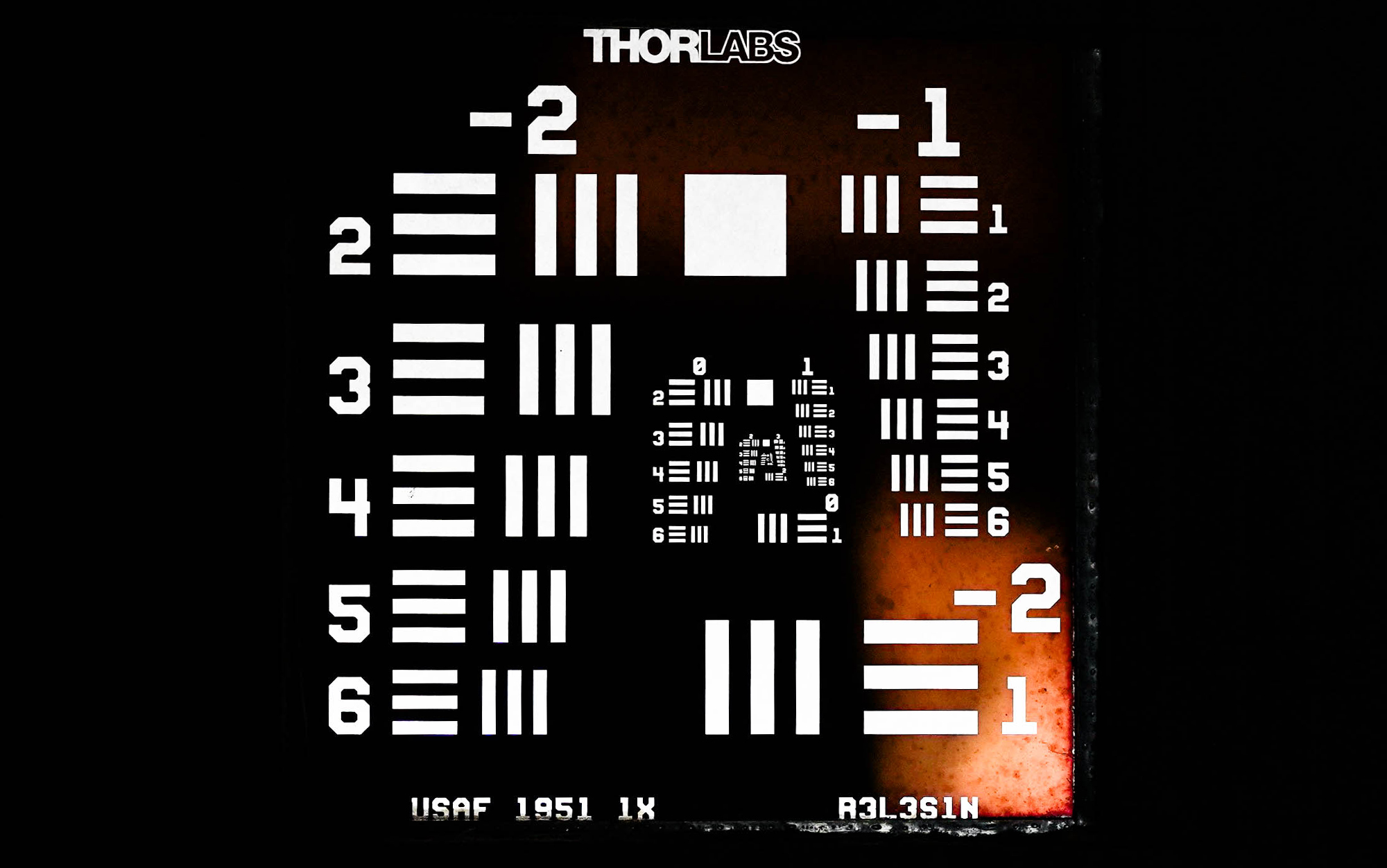
Optical performance includes the resolution and low-light tests plus the more subjective assessments of image quality and brightness. Mechanical performance assesses the durability of the submission along with its controls: focus and diopter controls, eyecup extension, and comfort. Design considers the exterior finish, interior blacking, tripod mount, and its innovation and versatility along with its comfort. We ask testers to evaluate this critical question: How long could you glass with this binocular?
And then our price/value score rates how much optic — along with warranty and amenities such as carrying case or harness — you get for your money. The binocular that gets the highest overall score wins our best overall award for the best in the category; the optic with the highest price/value score wins our best value recognition.
For some entries of this roundup of hunting binoculars, we are using test results from previous years, but we tested most of these members in our big 2024 optics test.
How We Grade Binoculars
Our 10-point evaluation adds up to a total numeric score, but we translate those to grades for each submission. The optical performance grade combines the scores from resolution, low-light, image, and brightness. Our mechanical performance grade aggregates the mechanics and durability score. The design grade considers construction, innovation, versatility, and comfort. And then the price/value grade is our value grade.
To earn an “excellent” grade, the average of that category must be nine or higher, which is extremely hard to achieve. “Very good” is an average score of seven to nine. A “good” grade is five to seven. Our “fair” grade is three to five, and “poor” is anything under three.
Best Hunting Binoculars: Reviews & Recommendations
Best Overall: Swarovski NL Pure 10×52
Score Card
- Optical Performance: Excellent
- Mechanical Performance: Excellent
- Design: Excellent
- Price/Value: Good
Key Features
- Wasp-waist, open-barrel design
- Center-wheel diopter control
- Oversized focus wheel
- Field of View: 426 feet at 1,094 yards
- Also available in 32mm and 42mm models
- Weight: 36 ounces
- Price: $3,449
Pros
- Premium field-flattener lenses
- Tapered tube design enables shake-free holding
- Premium glass and coatings
- 10-foot close focus
- Lightweight
Cons
- At $3,449, a wildly pricey binocular
- Non-locking diopter
- Tripod mount sold separately
Once you recover from the sticker shock of this Austrian-made binocular, find a way to experience the image and the design that starts to justify its price of $100 per ounce. In terms of image quality, low-light performance, and ergonomics, the NL Pure is one of the most remarkable binoculars Outdoor Life has ever tested.
Its distinctive external lines are purposeful. Swarovski introduced the roof-prism NL Pure four years ago in three configurations: 8×42, 10×42, and what seemed like a crazy magnification at the time, a 12×42. That high-power binocular works as a shake-free hand-held optic because of its balance and the balance-enhancing barrel shape.
This year the Austrian optic company is extending the line with a series of 52mm binos. The 14×52 version is in our large-frame binocular test, and requires stabilization to perform to its potential. The 10×52 is a better balance of hand-holdability, image delivery, and overall handling.
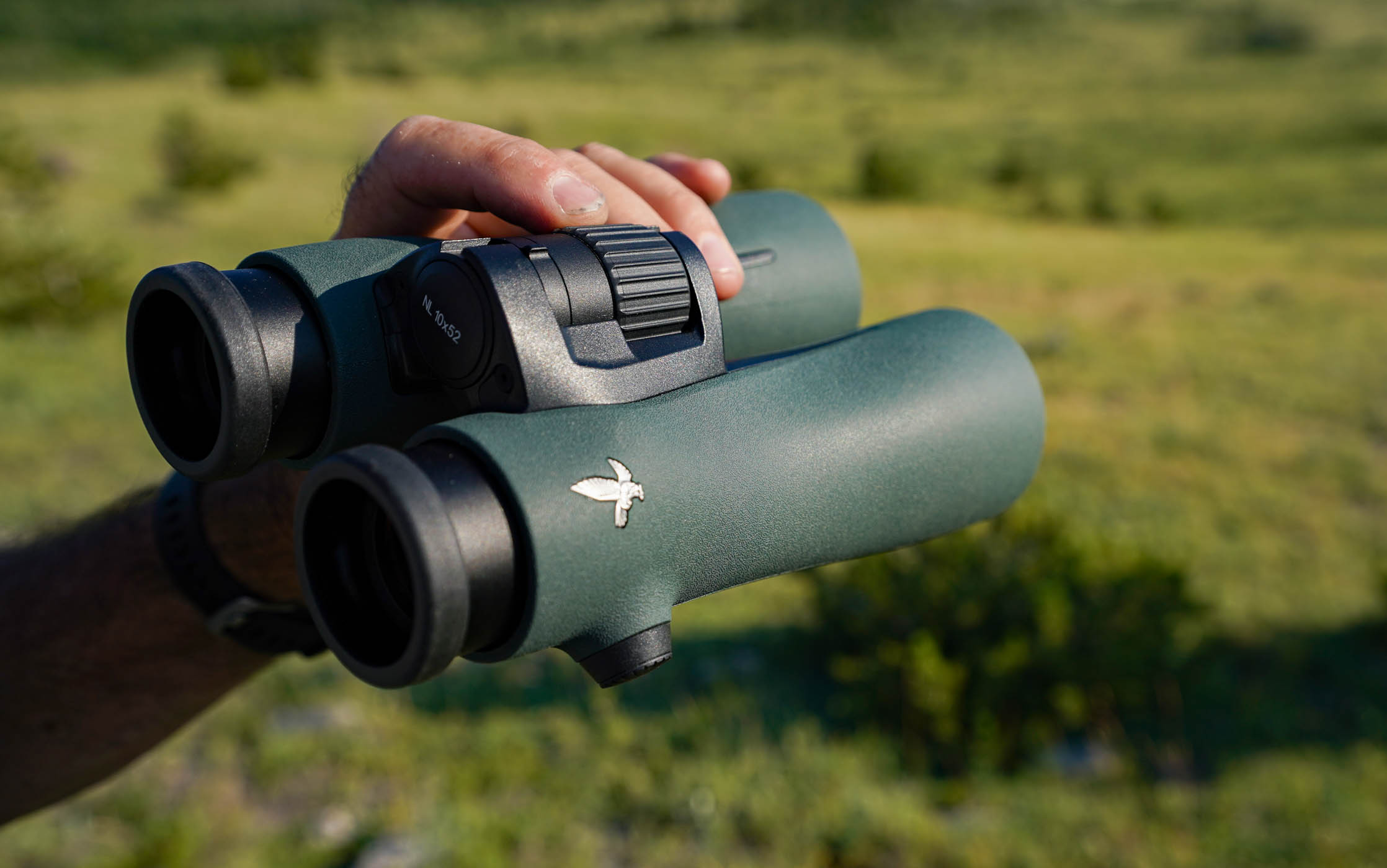
Scott Einsmann
Swarovski calls the NL Pure a “wasp-waist” design, and a new optical prescription and redesigned prism allow the chassis to accommodate big objective lenses, a slender mid-section, and large eyepieces fitted with field-flattener lenses that enhance edge sharpness. The design also enables a monstrous field of view. The 10-power NL Pure has a 426-foot FOV at about 1,100 yards (the strange math is because I’ve converted from metric meters). That’s even wider than most 8-power binoculars, and far wider than any other 10-power that we’ve tested. If you’re a glasser that appreciates panoramic images and the ability to take in wide swaths of landscapes, the NL Pure is for you.
This binocular is decidedly not for you if you want to mount it to a standard tripod. One of the more frustrating aspects of Swarovski’s design is its proprietary front-hinge tripod socket. Instead of being fit with a standard ¼-20 thread, the NL Pure has a special click-lock socket that only accepts Swaro’s tripod mount, which sells for an additional $200. A cheaper alternative is to buy the $60 NL Pure adapter at Outdoorsmans and install it yourself. But either way, it’s an affront to working-class glassers to have to buy an aftermarket tripod mount after spending $3,500 on the binocular.
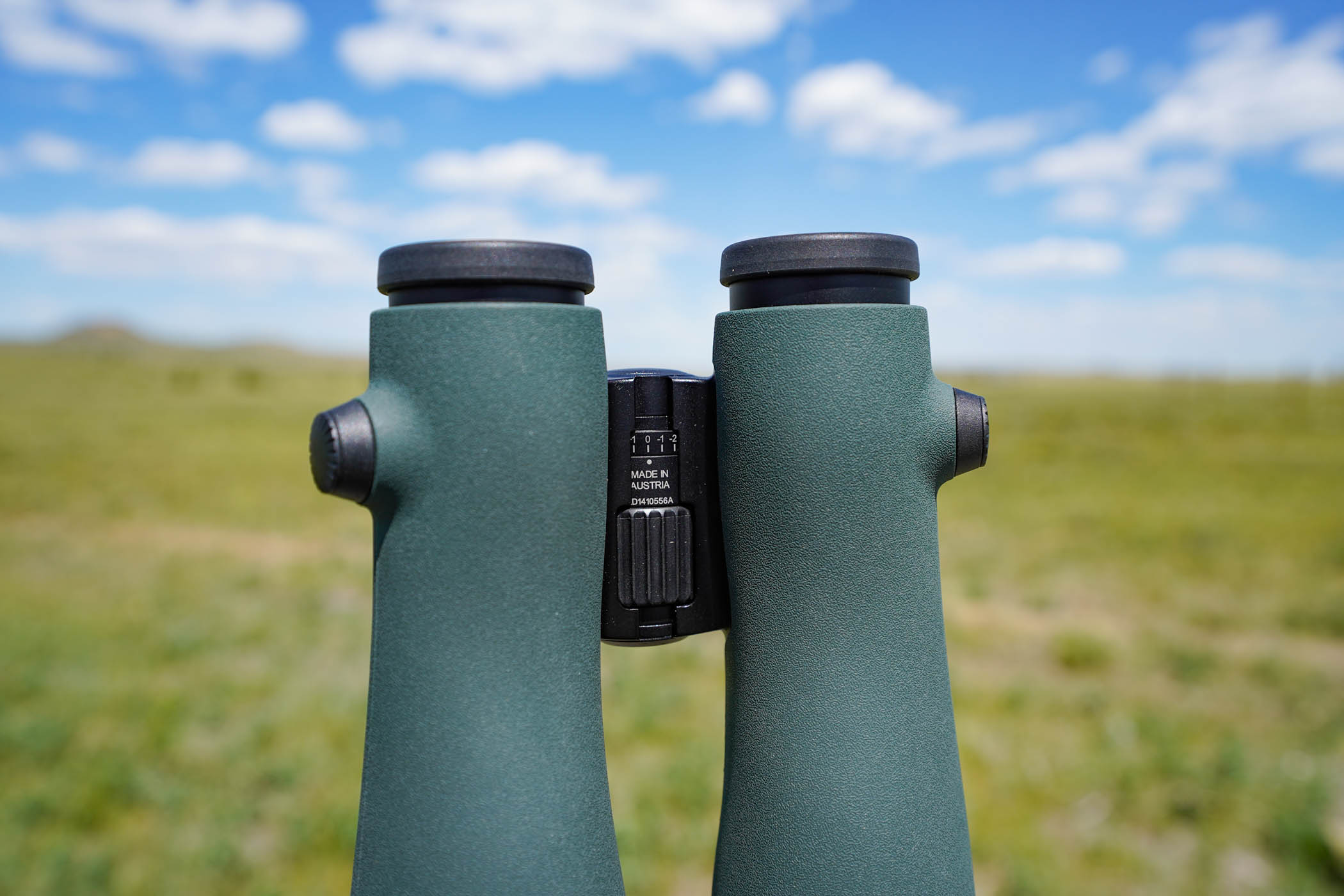
Testers also dinged the NL Pure for its non-locking center-dial diopter, which features a tab that can easily get bumped off plumb, especially if users employ enclosed bino harnesses. Evaluators had mixed reviews of Swaro’s proprietary harness mounting system, which features push-to-turn locking studs that hold straps to the chassis. The system, while elegant, requires users to stick with Swarovski’s hardware, and to buy expensive replacements when they inevitably lose one or both of the studs.
But these external nuisances distract from the NL Pure’s astonishing image. The binocular easily won our low-light test, thanks to premium glass and coatings and those huge 52mm objective lenses. The image delivered by the NL Pure is so vibrant, bright, and pleasing that testers gravitated to the Swarovski any time they wanted to get a better look at a distant object. That’s the best testament to a world-class optic: that users spend more time behind it. And as hunters know, the more you look with an optic, the more you’ll see, and the more successful you’ll ultimately be in the field. It’s hard to put a price on that level of performance.
Best Value: Vortex Triumph HD 10×42
Score Card
- Optical Performance: Fair
- Mechanical Performance: Good
- Design: Good
- Price/Value: Very Good
Key Features
- Single-hinge, closed-bridge design
- Roof-prism design
- Right-barrel diopter control
- Fully transferable lifetime warranty
- Tripod adaptable
- Weight: 22.9 ounces
- Price: $99
Pros
- Ships with excellent GlassPak harness
- Light
- Extremely accessible real-world street price of under $100
Cons
- Significant peripheral distortion
- Flimsy feeling
How on earth can Vortex bring a capable binocular to the masses for under $100? With a good bino harness and the brand’s legendary warranty? Those were questions our test team batted around as we handled this entry-level binocular. Then we got behind the lenses and learned some of the answers.
The biggest answer is the class of glass inside the new Triumph HD is cheap. The Vortex received uniformly downbeat assessments in optical performance; it scored near the bottom in low-light brightness, and its resolution score was just below the median. Testers further complained about blue color fringing, noticeable edge distortion, and blurry focus.
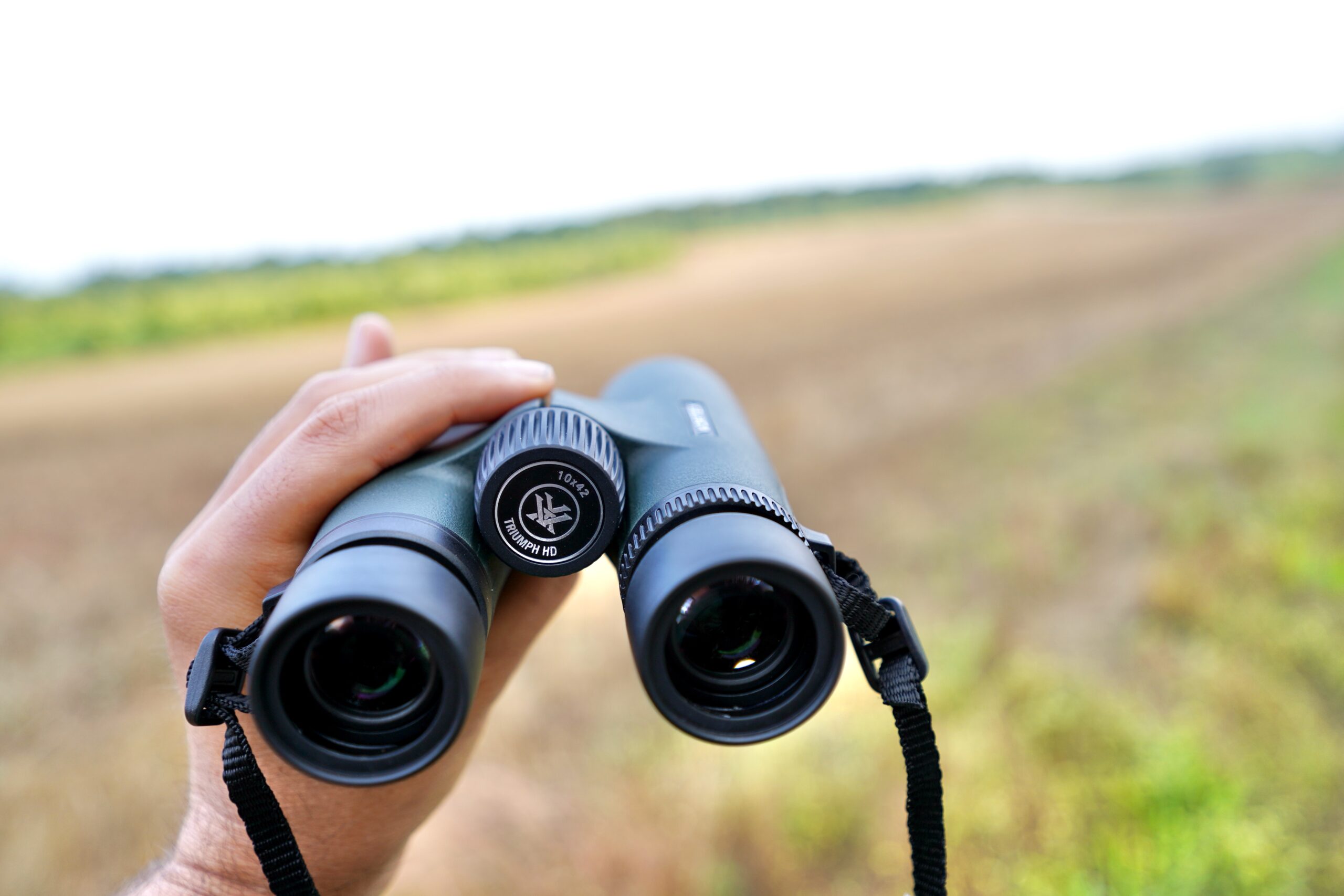
But we also recognized that you shouldn’t expect world-beating glass inside a $99 binocular, and that same realism pervaded our assessment of the Triumph’s mechanical performance. The diopter adjustment is stickier than we’d like, and the overall build feels flimsy. But the tapered eyecups move with positivity and the focus wheel is tight and responsive. The texturing, balance, and overall design is better than we’d expect for the price.
On the value side of the ledger, the GlassPak case and integrated harness confirms the best value designation we gave the Triumph HD. This would make a very good first optic for a hunter, birder, or shooter, and if treated gently is a good choice to throw in a pickup or cabin. We’re not sure how much rough handling this bino can take, but Vortex’s excellent warranty and customer service is a cheering consolation.
Read Best Binoculars for the Money to see more high-value binoculars.
Best Compact: Zeiss SFL 8×40
Score Card
- Optical Performance: Very Good
- Mechanical Performance: Excellent
- Design: Excellent
- Price/Value: Very Good
Key Features
- Double-hinge, open-barrel design
- Right-barrel diopter control
- Oversized focus wheel
- Extremely light weight
- Also available in 10×40, 8×30, and 10×30 models
- Weight: 22.6 ounces
- Price: $1,800
Pros
- SmartFocus wheel zooms from close focus to infinity in 1.4 turns
- DoubleLink Bridge enables good barrel grip
- Premium glass and coatings
- 4.9-foot close focus
- Light
Cons
- At $1,500, fairly pricey binocular
- Straps and case are pedestrian
The world of premium binoculars apparently has no upper limit. You’ll pay over $3,000 for Swarovski’s excellent NL Pure or for Leica’s stunning Noctovid. Zeiss, too, asks $3,000 for its marvelous Victory SF binocular. So to find a binocular that performs nearly on par with those flagship models for half the price is worth talking about.
Zeiss saves some money on its SFL model by importing it from Japan; most premium optics are made in Germany, Austria, or Portugal. And Zeiss found some additional savings in glass by using thinner lenses than it uses in its SF line. Those thinner lenses also allow the SFL to shave nearly a half pound from the SF in the same configuration.
But the image delivered by those halfling lenses is every bit as sharp and vibrant as those of Zeiss’s other premium binoculars. The SFL easily posted the top resolution score at last year’s optics test, and testers raved about the vibrant image with rich contrast and stunning colors. It lost points on disappointing low-light performance, which was partly due to its diminutive 8×40 configuration.
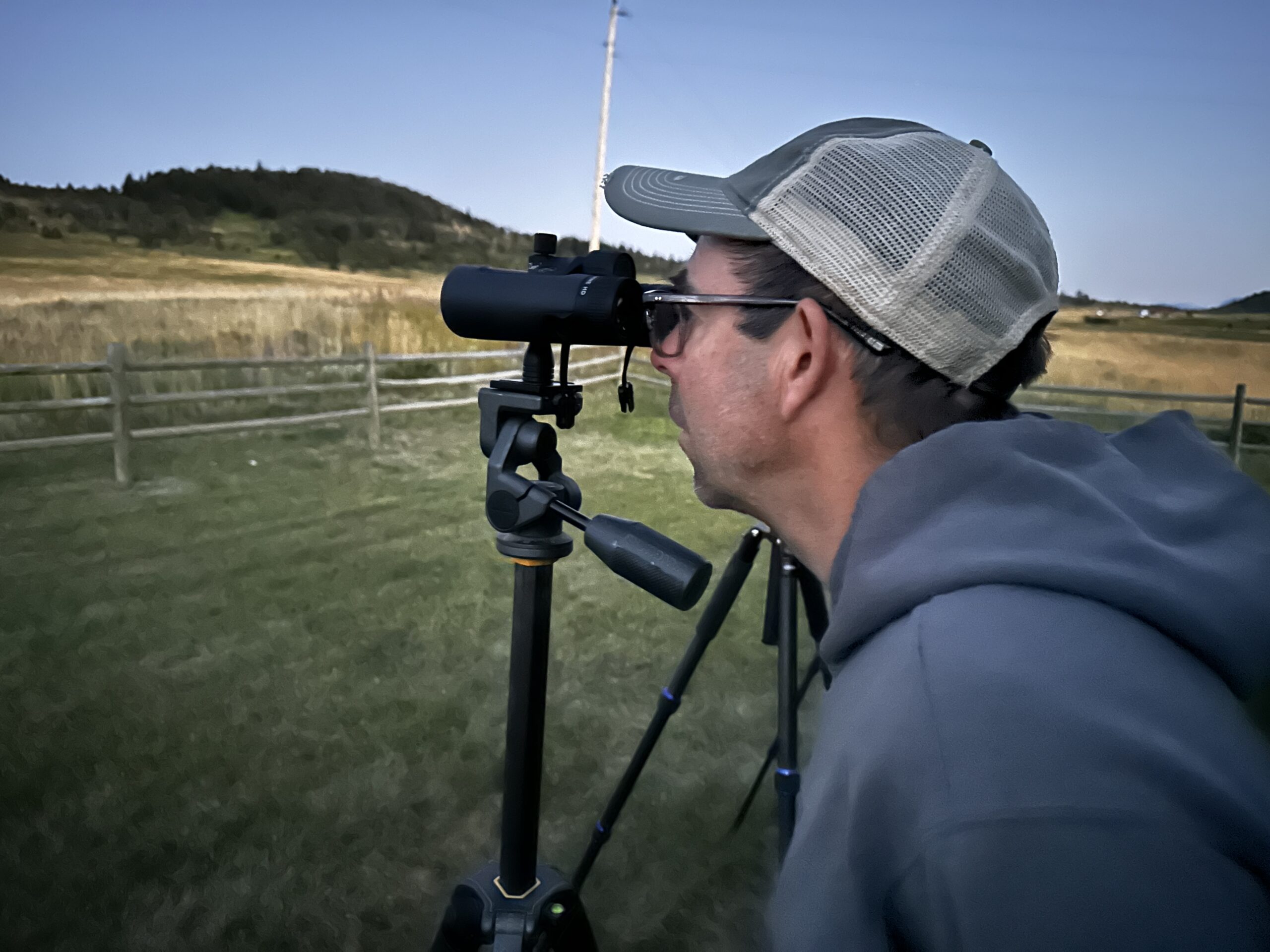
But the reason the SFL is here as one of the best hunting binoculars is its field-worthy operation. Its oversized focus wheel riffs from an extremely tight close focus of 4.9 feet out to infinity in just 1.4 rotations of the wheel. That’s a huge asset for brush hunters, who use their optics to pick apart various distances, and for Western hunters, who might pan from middle-distance cover out to far vistas in the same field of view. The focus wheel, it should be noted, moves as though it rides on ball-bearing tracks, so smooth and fluid.
The Zeiss’s name stands for SmartFocus Lightweight, and the 1.5-pound heft makes them the lightest premium binos on the market, and a wonderful companion for long hikes over difficult terrain. The balance and grip provided by the open-bridge design makes the SFL feel even lighter, and testers gave high praise for the binocular’s tapered eyecups that were extremely comfortable to use for extended periods.
That’s the real question to ask of a hunting binocular — how long do you want to spend behind it? The more and longer you use a binocular, the more game you’ll spot and the more successful you’ll be. Few other pieces of hunting gear have that outsized effect on your outcome. If the 8×40 isn’t for you, look to the SFL in 10×40, 8×30, and 10×30.
Read Next: Best Rangefinders for Hunting
Best for Bowhunting: Vortex Razor UHD 8×32
Score Card
- Optical Performance: Excellent
- Mechanical Performance: Very Good
- Design: Very Good
- Price/Value: Very Good
Key Features
- Open-hinge open-barrel design
- Right-barrel locking diopter control
- Tripod-mountable
- 5.9-foot close focus
- Weight: 21.9 ounces
- Field of view: 472 feet at 1,000 yards
- Price: $1,450
Pros
- Durable magnesium chassis
- Premium glass
- Easy to use with a single hand
- Oversized focus wheel
- Ships with premium GlassPack Pro harness with rangefinder pouch
Cons
- At nearly $1,500 street price, expensive for an 8×32
- Thumb indents could be larger to accommodate large hands
Vortex’s new flagship binocular has it all: excellent glass, nice handling, a durable build, and wonderful field of view. The compact 8×32 in our test produces a big image out of proportion to its size, and testers noted it’s a perfect bowhunting optic, since it can be capably handled with a single hand and offers excellent mid-range performance. Enhancing its handling, whether you use one hand or two, the Razor UHD features thumb indentations in the chassis that are placed at the balance point of the binocular. That added touch allows for good gripping, though one ham-handed tester wanted these depressions to be a bit larger to fit his silver-dollar-sized thumbs.
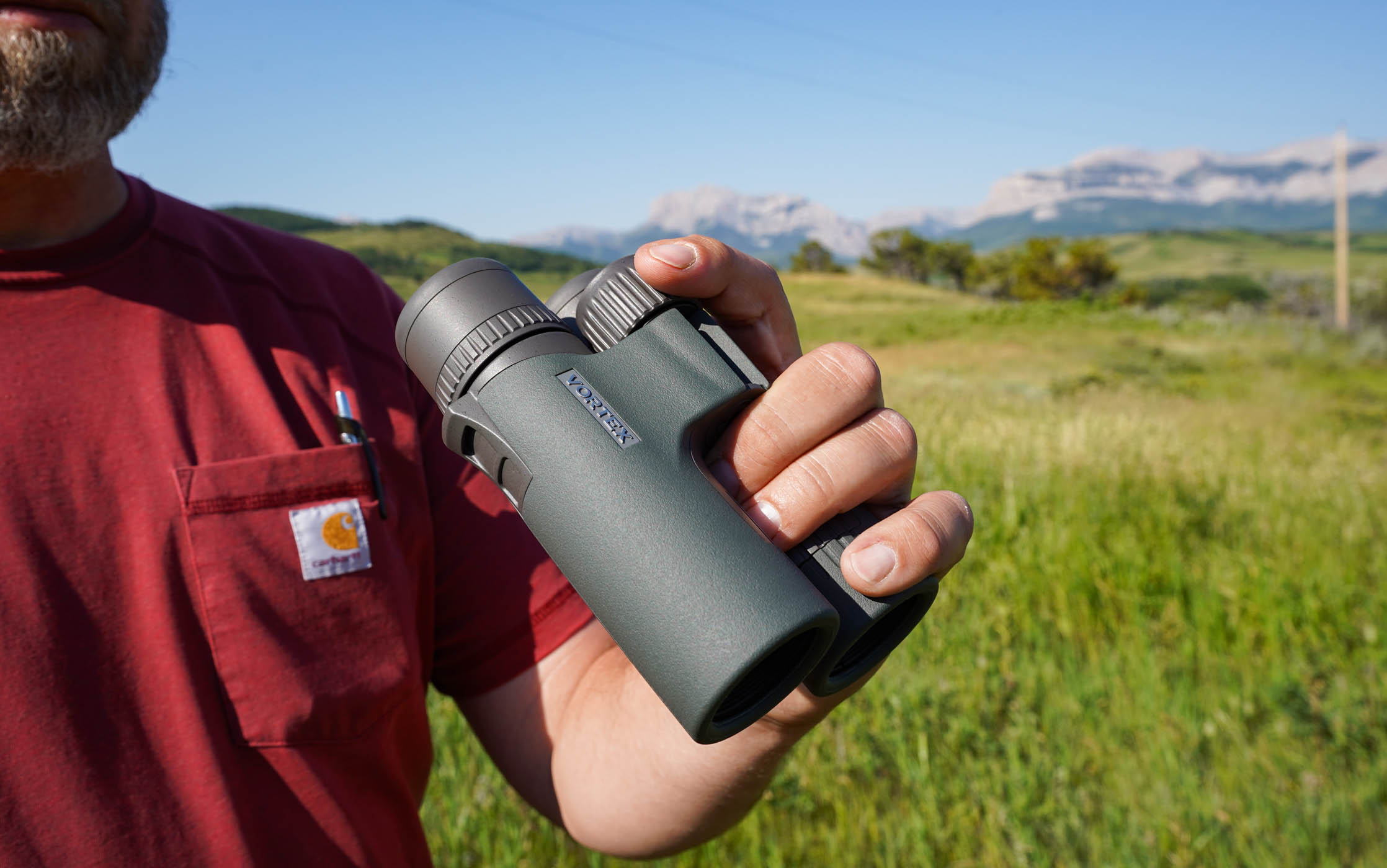
Scott Einsmann
The 8×32 joins a compact 10×32, both introduced this year, to fill out Vortex’s excellent Razor UHD line, which includes 10×42, 10×50, 12×50, and 18×56 models. The literalists of our test noted that the term UHD, which stands for Ultra High-Definition glass, doesn’t have a defined meaning. It’s a marketing term to refer to a higher grade of glass and coatings than those used in Vortex’s HD (pedestrian High-Definition) optics.
Regardless of semantics, its exceptional glass and coatings allowed the 32mm Vortex to hang with big 42mm and even a 52mm binocular in our low-light test. Other accolades for the Razor UHD include a locking diopter, fast-focus wheel, and thin eyecups that fit most brows. Perhaps recognizing that $1,500 is a lot to spend on a binocular, Vortex adds its very good GlassPak Pro harness and rangefinder pouch to the deal. Those accessories retail for around $150.
We did note a surprising aberration. Testers recorded noticeable flaring when they peered toward the sun, an optical anomaly that may be caused by dust on an interior lens. We didn’t expect to see that in an optic at this price point.
But most users are unlikely to notice that demerit, one of the very few in an otherwise capable, fine-handling, and extremely bright binocular. Given Vortex’s fully transferable lifetime warranty and exceptional customer service, any deficiencies that users note are bound to be covered by the company.
Top Binocular Innovation (Form-Fit Eyecups): Leupold BX-4 Pro Guide HD 10×42 Gen 2
Score Card
- Optical Performance: Good
- Mechanical Performance: Good
- Design: Very Good
- Price/Value: Good
Key Features
- Double-hinge open-barrel design
- Locking center-hinge diopter control
- Interchangeable “Form-Fit” eyecups
- Tripod-mountable
- 9.3-foot close focus
- Weight: 25 ounces
- Field of View: 314 feet at 1,000 yards
- Price: $600
Pros
- Aluminum chassis
- “Slim-hinge” design enhances one-hand operation
- Field-proven glass and coatings
- Ability to change eyecups in the field
- Ships with Go Afield bino harness ($50 value)
Cons
- Underwhelming glass
- Spongy focus
- Non-textured armor is slick
With configurations in just about every practical size and magnification, you might consider Leupold’s new BX-4 Pro Guide HD the binocular equivalent of its new Mark 4HD line of riflescopes: mid-priced do-everything optics.
Leupold introduced BX-4 Pro Guide HDs earlier this year in 8×42, 10×42, 10×50, and 12×50 configurations. We considered the 10×42 in our mid-sized bino test, where it fit nicely between premium optics costing well over $1,000 and entry-level optics priced around $300.
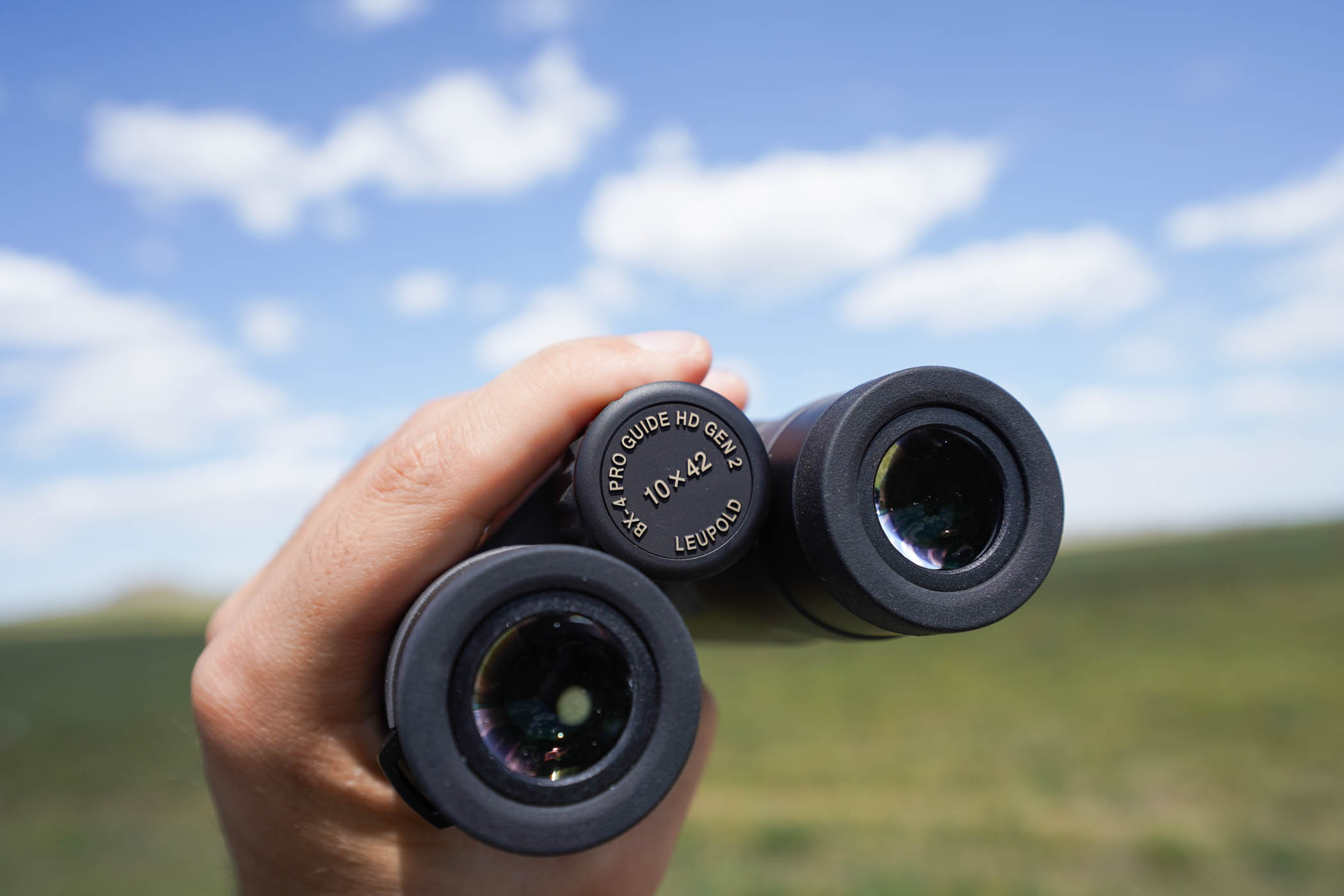
Scott Einsmann
“This is by far the best sub-$600 bino in the field,” wrote tester Dale Manning. Other testers praised the model’s open-barrel handling, locking center-hinge diopter, and innovative interchangeable eyecups. That last attribute — Leupold ships three different pairs of “Form-Fit” eyecups with its BX-4 Pro Guide HD, low- and medium-profile sets and a winged version designed to block out peripheral light — is an important point of distinction for the new line. It also answers the question: How can brands possibly improve the basic binocular? Well, Leupold has found a way.
We wish the image produced by the BX-4 Pro Guide HD was on par with its mechanics, handling, and eyecup innovations. Every tester recorded distracting blue color fringing, and most noted edge distortion. The field of view (stated at 314 feet at 1,000 yards) is noticeably narrower than most 10x42s and the apparent field of view is even more stingy. On the handling side, some testers noted that the tripod mount, located on the forward-most hinge, creates imbalance. We’d like to see that tripod mount on the interior hinge to better balance the unit.
That’s an admittedly minor quibble, considering that few users will mount a 10×42 binocular to a tripod. As a knock-about binocular that can capably handle just about any viewing conditions, the new Leupold line is more than adequate. The addition of easily interchangeable eyecups, which accommodate not only most facial features but also changing field conditions, is a true innovation that we expect to see replicated by other binocular brands.
Best Entry-Level: Hawke Frontier ED X 8×42
Score Card
- Optical Performance: Very Good
- Mechanical Performance: Good
- Design: Very Good
- Price/Value: Excellent
Key Features
- Closed-bridge design
- Right-barrel diopter control
- Tripod-mountable
- 6.6-foot close focus
- Weight: 25.6 ounces
- Field of View: 426 feet at 1,000 yards
- Price: $450
Pros
- Durable magnesium-alloy chassis
- Extra-low-dispersion (ED) glass
- Nicely textured controls
- Thin-profile tapered eyecups
- At less than $500, fairly priced
Cons
- Low-geared focus wheel
- Noticeable flaring
While it’s not widely known to American hunters, this British optics brand has sizeable market share internationally, especially among birders. The Frontier ED X, built around very good extra-low-dispersion glass and responsive controls, is a good example of the brand’s mid-priced, value-packed optics.
For an 8-power competing in a field of 10-power binoculars, the Frontier ED X held its own, scoring near the bottom of the low-light test but posting an exceptional resolution score. Testers like the trim eyecups and the nicely textured armor, though tester Ky Idler noted that the rubber armor on our sample was a little loose where it joins the objective lens rim, a demerit that might introduce dust and grit into the chassis.
Image scores were in the middle of the field. Testers generally liked the brightness, edge sharpness, and overall tone of the image, but most noted flaring and other optical aberrations, probably as the result of poorly finished interior blacking. The focus wheel also requires nearly three revolutions to zoom from close focus to infinity. One of the quiet advancements in binocular technology is focus wheels that cover the entire focal length in two or fewer revolutions, and we’d like to see the Hawke apply this to its offerings.
Like others in the Frontier ED X line — Hawke has versions in both grey and green armor in 8×32, 10×32, and 10×42 in addition to the 8×42 of our test — the binocular ships with a premium zippered vinyl semi-hard case and carry strap, a feature that added to its high price/value score.
Best Mid-Price Glass: GPO Passion SD 10×42
Score Card
- Optical Performance: Good
- Mechanical Performance: Good
- Design: Fair
- Price/Value: Good
Key Features
- Central-bridge design
- Right-barrel diopter control
- Tripod-mountable
- Weight: 24.6 ounces
- Field of view: 314 feet at 1,000 yards
- Price: $450
Pros
- Durable magnesium chassis
- Classy black-and-silver colorway
- Oversized focus wheel
Cons
- Two-position eyecups
- Spongy focus
- Rubber armor loose on chassis
With a real-world street price of about $400, there’s a good deal of value in this new line of binoculars from German Precision Optics, better known as GPO. In addition to the 10×42 in our test, the company is bringing to market 8×26, 10×26, 8×34, 10×34, and 8×42 models. Each wears the “SD” designation.
What does “SD” mean, exactly? “Substantial Definition,” according to GPO’s marketing materials.
That’s a meaningless optics term, even more bewildering than “high-definition” or “ultra definition” or the new favorite, “ultra high-definition.” As an optics tester, I’m constantly trying (in vain) to find out what differentiates HD, UHD, and now SD glass from its competitors. The GPO version seems to be a variety of high-transmission glass, which is a slightly higher grade of optical glass than that with no designation, but damned if I can tell you how much better it is. That’s why in our test we rely on what we see through the glass, rather than what marketers tell us we should see.
The new Passion SD glass actually isn’t that bad. Every tester noted some fairly distracting flaring, but it’s hard to say if that’s because of sub-premium glass or the noticeable dust on interior lenses. Internal lenses are nicely coated, and interior blacking is excellent. We also appreciate the high-quality zippered case and strap that ships with the Passion SD.
GPO is bringing the Passion SD to a very competitive place in the market. But it stands out for its magnesium chassis — many $400 binoculars are built on polycarbonate bodies — and that high-transmission glass. The in-hand feel is both substantial and tight, though testers wished the focus wheel wasn’t so spongy. We have no reason to doubt its durability and overall versatility.
Best Budget: Bushnell R5 8×42
Score Card
- Optical Performance: Fair
- Mechanical Performance: Fair
- Design: Good
- Price/Value: Very Good
Key Features
- Mid-barrel bridge design
- Right-barrel diopter control
- Tripod-mountable
- 7-foot close focus
- Weight: 24.9 ounces
- Field of View: 393 feet at 1,000 yards
- Price: $210
Pros
- At just over $200, nicely priced
- Nicely armored
- Double-textured controls
- Two-tone armor boosts shelf appeal
- Ships with useful Vault Lite chest harness
Cons
- Thumb detents too shallow
- Eyecups are hard and square
Pity our reviewers. They get the opportunity to field-test the sharpest, brightest, and most expensive field optics on the market, which can blind them to the requirements of mere mortals: the need to choose the best optics for more modest prices. That’s where our Great Buy award can steer buying decisions to those products that offer a ton of value for the price.
The brand-new R5 line from Bushnell, winner of our great buy award, is one of those smoking deals that won’t turn the heads of readers who are Zeiss, Leica, and Swarovski acolytes. But the Bushnell, which should retail for just over $200, offers decent performance and abundant versatility for a very accessible price.
“This would make a great kids binocular,” says tester Ky Idler, who liked the no-nonsense handling, decent glass, and fully transferrable lifetime warranty. Fellow tester Dale Manning similarly appreciated the value of the Bushnell, but also noted its hard eyecups, shallow thumb detents, and internal smudging.
There’s every chance you’ve never heard of the R5. That’s because it’s a brand-new product line from Bushnell, positioned between the new entry-level R3 line and the more aspirational R7 family of binoculars and riflescopes. Think of the R5 as the mid-tier Engage in Bushnell’s previous Prime/Engage/Forge lineup of optics.
The R5 is sourced in China, and has some forgettable attributes, including its ho-hum glass and spongy controls. But one of the advantages of an established optics company like Bushnell is that even its price-point products benefit from its excellent coatings. The R5’s exterior lenses are coated with Bushnell’s EXO Barrier that cuts glare and boosts color fidelity. Adding to its value, the R5 ships with Bushnell’s very good Vault Lite chest harness.
This is more than a kids’ binocular. It’s a great value on an optic that should serve several seasons of honest use while its owner saves up to buy more aspirational optics.
Best Value Truck Binocular: Riton 5 Primal
Score Card
- Optical Performance: Good
- Mechanical Performance: Fair
- Design: Fair
- Price/Value: Fair
Key Features
- Closed-hinge design
- Right-barrel diopter control
- Tripod-mountable
- 4 ½-foot close focus
- Weight: 26 ounces
- Field of View: 380 feet at 1,000 yards
- Price: $500
Pros
- Aluminum-alloy chassis
- Extra-low dispersion glass
- Long eye relief for eyeglass wearers
- Three-position eyecups
Cons
- Arbitrary focusing
- Spongy focus control
- At about $650, pricey
This is a very good $225 binocular that seems to be mispriced at about triple that amount. That may be a function of its better-than-expected extra-low dispersion glass, or an optic that’s price-positioned for deep discounting after it hits the market, but the controls that surround the internal works are at best forgettable and at worst curse-causing.
“I had a hard time keeping a tack-sharp focus,” reports tester Dale Manning. “I can’t put my finger on it, but this binocular gave me a headache.”
Other testers similarly reported spongy or imprecise controls. That’s too bad, since the Riton’s very good glass ruled our low-light test, holding its own with European-sourced optics that cost four to five times the price of the 5 Primal.
But the binocular’s sharp extra-low dispersion glass is degraded by obtuse controls. Not only is the focus spongy, but the diopter is soft and mushy, and the otherwise excellent armor is loose-fitting around the barrels. If priced at the same point as the Bushnell R5, this would be a contender for our great buy award, but at over $600, we question the value of the 5 Primal.
How to Choose a Binocular for Hunting
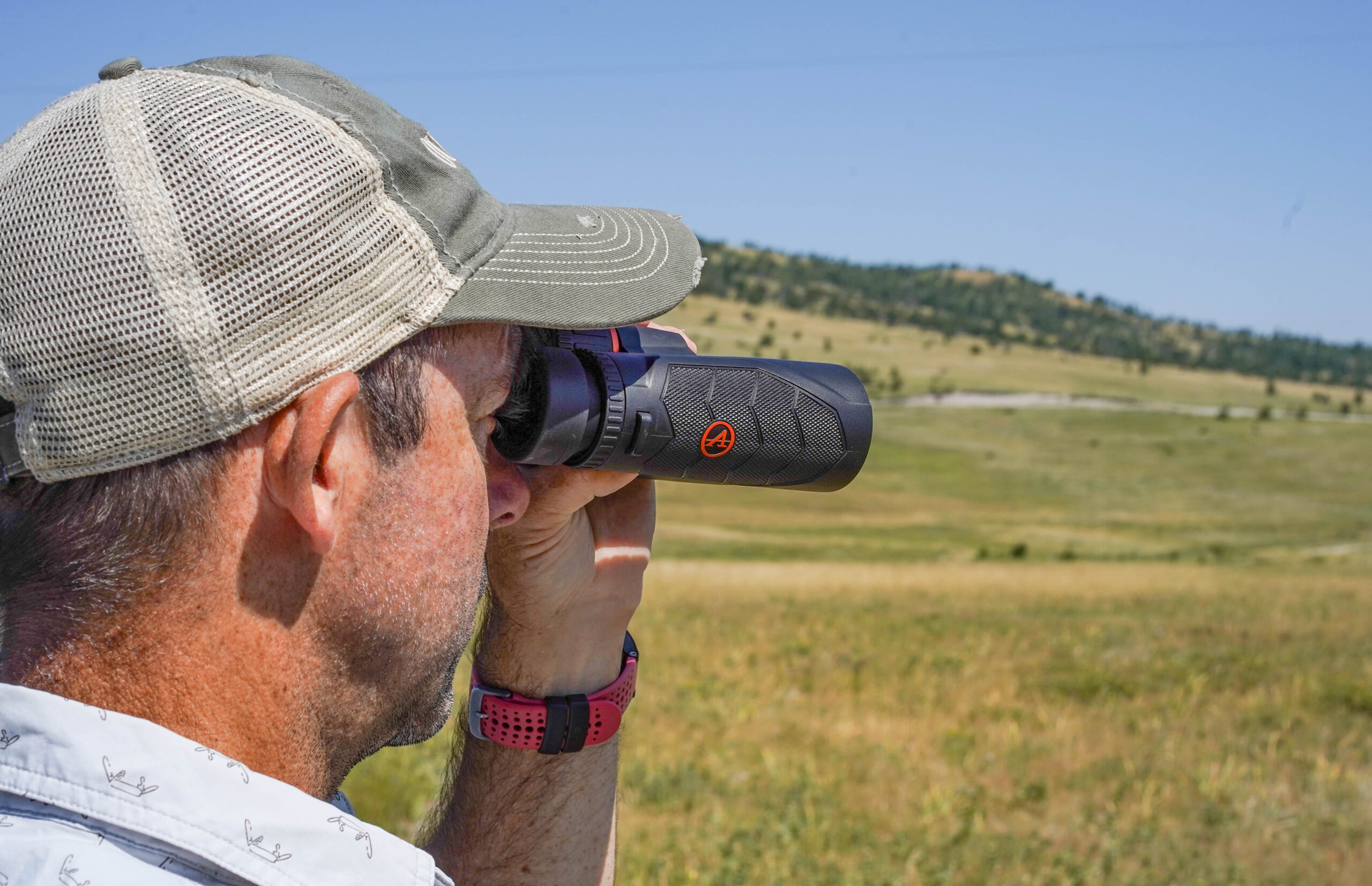
There is no shortage of binoculars that can serve as adequate hunting binoculars, so what qualities elevate an optic into our ranks as the best in the business? The first is consistent performance. We removed from consideration those models with fussy focus knobs and eyecups that slip or crack. But the biggest factor for us is glassing comfort. Does the binocular fit our hands and face? Is the glass clear and bright enough that we want to keep using it? The more pleasing the glassing experience, the more you’ll glass. The more you glass, the more game you’ll see and the more successful your hunt. Most of that credit goes to a good binocular.
Of course, there are plenty of other attributes to consider. How durable is the binocular? We’re not proud to report that we abuse our optics in the course of a season, as we hunt hard over uneven terrain. The best hunting binos have excellent armor and rugged controls that work in below-zero temperatures, in rain, and when we’re wearing gloves.
Lastly, we picked a variety of magnifications, chassis sizes, and capabilities because every hunt is different, and you want to pick the model that matches the way you hunt. If you’re hunting a tight woodlot in Connecticut, you don’t need a big 12-power binocular with a laser rangefinder. But if you’re hunting Dall sheep on an open Alaskan mountain ridge, you want as much optical and laser rangefinding horsepower as you can get to make positive identification of your target and then an anchoring shot.
It’s been said that you want to pick the most expensive optic that you can afford, because price and performance are directly proportional when it comes to binoculars. And confirm the warranty and customer-service reputation of the brands, too. If you hunt as hard as we do, there’s every chance that at some point or another, you’ll need to activate the warranty.
FAQs
The short answer is yes. For safety, because binoculars enable you to see distant objects without pointing your gun at them and using your riflescope as a telescope is never a good idea. Ethically, you need to make sure of your target before shooting at it. For efficiency, because binoculars shrink distance and allow you to assess far objects without walking all the way to them. And for success, because binoculars help you see distant animals in the first and last hours of the day, when they’re most likely to be moving.
Every binocular has two numbers. The first is the magnification, or the amount of times the image is enlarged. The second is the size of the objective lens, in millimeters. The objective lens is the larger lens that points toward your target when you look through a binocular, and the larger the objective lens, the more light and detail enter the eye. Using this formula, an 8×32 binocular has 8-times magnification (or “power”) and a 32mm objective lens.
If you’re still wondering, what do numbers on binoculars mean, here are more tips. Typically, the larger the numbers, the greater the optical performance, but also the physical size of the binocular. A 6×24 binocular is small enough to fit in a shirt pocket. A 15×56, on the other hand, is so large it’s hard to hold in your hand. Hunters want a binocular that is powerful enough to see distant objects but small enough to be portable. The sweet spot for most hunters is an 8- or 10-power behind a 32 to 42mm lens. So look for models with these numbers: 8×32, 8×42, 10×42, or for light-gathering ability, 10×50.
You can spend as little as $100 or as much as $4,000 for a hunting binocular. Generally, the more money you spend, the better the binocular, but because there’s a limit to your budget, you probably want to buy the best binocular for your money. The good news is there are lots of choices in the $400-$600 range. That’s still a lot of money, but here are three things to consider:
• Warranty – Does your brand have your back? Many optics companies offer fully transferrable lifetime warranties for binoculars. That means it’s covered for repair or replacement whether you bought the optic yourself or bought it second-hand.
• Accessories – Many brands include zippered cases or harnesses with their binoculars, a savings of around $50.
• Performance – If you spend $500 or more for an optic, you want to be sure it’s going to deliver. Look for models that have high light transmission (90 percent or higher), good customer reviews, and are built for battle, with double hinges, durable armor, and controls (focus wheels and eyecups) that move with precision and authority.
Final Thoughts on the Best Hunting Binoculars
This is admittedly a partial list, but it’s based on both empirical performance of hunting binoculars in the course of our optics testing, and it’s based on our own experience with several of these models in the field. Consider it a good starting point for your own search. The main point: Don’t check out one binocular and consider your work done. You’ll want to put several contenders in a head-to-head test and compare and contrast their performance against each other. If you’re still not satisfied, then keep pairing up contenders until you find one that fits your style, particular optical prescription and physical dimensions, and your budget.
- Best Overall: Swarovski NL Pure 10×52
- Best Value: Vortex Triumph HD 10×42
- Best Compact: Zeiss SFL 8×40
- Best for Bowhunting: Vortex Razor UHD 8×32
- Top Binocular Innovation (Form-Fit Eyecups): Leupold BX-4 Pro Guide HD 10×42 Gen 2
- Best Entry-Level: Hawke Frontier ED X 8×42
- Best Mid-Price Glass: GPO Passion SD 10×42
- Best Budget: Bushnell R5 8×42
- Best Value Truck Binocular: Riton 5 Primal












